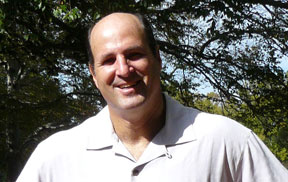Robbins inspires writers at alma mater
 With seven published novels, an eighth due out in January, and a ninth
in the works, bestselling novelist David Robbins (’76, J.D. ’80), has
won accolades as an author. As this year’s Scott and Vivian Donaldson
writer-in-residence at the College, Robbins seeks to inspire aspiring
writers.
With seven published novels, an eighth due out in January, and a ninth
in the works, bestselling novelist David Robbins (’76, J.D. ’80), has
won accolades as an author. As this year’s Scott and Vivian Donaldson
writer-in-residence at the College, Robbins seeks to inspire aspiring
writers.
A graduate of both the College and the Marshall-Wythe School of Law,
Robbins, referencing an approach he attributed to the late William
Styron, author of "Sophie's Choice," enjoys trying to “entertain,
educate, and elevate, all in equal proportions.” He said that he feels
“very honored” to have been selected to teach a fiction writing seminar
this year as part of William and Mary’s longstanding writers in
residence program.
“I like teaching,” Robbins said, explaining that he enjoys “taking the
mythos out of getting published.” He also finds that his students
motivate him to improve his own writing. “When I sit down to write
every day, the drums that are beating in that classroom are really
resounding in my head,” said Robbins. “I like the class—I like being
part of their struggle,” he said.
Students fortunate enough to study under Robbins this semester praised Robbins for his energetic approach to teaching.
“He gets very involved with students and works with us on anything we
bring to him,” Ben Farthing (’09) said in a telephone interview. “He
[has] taught me to say what I mean in the most artful and succinct
way,” he said.
Professor Nancy Schoenberger, who chairs the writer-in-residence
committee, said that the “glowing” reviews of Robbins’ former students
definitely factored into the committee’s selection of Robbins as the
College's 27th writer-in-residence.
“Among our creative writing core faculty, we look at writers who we
know, good writers, writers who have some experience, writers who have
the desire to teach for us,” Schoenberger said.
Schoenberger said she has received unusually positive feedback from
Farthing and other students enrolled in Robbins’ popular fiction
writing class. “David is a very dynamic personality and a very involved
teacher,” she said.
Because William and Mary does not have a full time tenured fiction
writer, the writer-in-residence program seeks to fill the void by
rounding out the English department’s course offerings.
“It brings in a fresh perspective every year,” Schoenberger said,
noting that the program also brings “a little bit of prestige to our
department.” Aware of Robbins’ commercial success, the committee hoped
that Robbins would offer students “a sense of what of what the
marketplace is like,” she said.
Several novels by Robbins have appeared on the New York Times
bestseller lists and his book War of the Rats was nominated for an
Audie award. Robbins has traveled as far afield as Russia and Cuba
while researching his novels, which include The Assassins Gallery, Last
Citadel, and The End of War. He said that driving a truck across Europe
in preparation for Liberation Road gave him crucial insight into the
grueling side of war.
At a public reading held on campus on Oct. 23, Robbins read selections
from The Betrayal Game, which will land on bookstore shelves in
January, and a novel on Chernobyl that he is currently writing.
Robbins is the second William and Mary alumnus hired as a
writer-in-residence since the English department created the program in
1971. Schoenberger, who first came to William and Mary as a
writer-in-residence in 1989, said that the fact that Robbins holds two
degrees from the College is “an added bonus.”
Reminiscing about his Tribe years, Robbins said that although he only
practiced law for 50 weeks after graduating from law school, he learned
valuable critical thinking skills that have made his writing more
technically grounded and his language more precise. He readily
acknowledged, however, that his “creative bent” eventually led him to
become a novelist.
“If I had to advise a young law student, I would say restrain your creative bent until you are on your own,” Robbins said.
Asked what advice he would give to aspiring fiction writers in general,
Robbins compared the writing process to an isosceles triangle, with the
wide base of the triangle formed by “hard work, repetition, and
discovery of your own voice.”
“You can be an artist when you write but you have to be a technician
when you edit,” Robbins said. As a teacher, Robbins has allocated less
than one hour of class time to plot development, focusing instead on
“craft” development. “Buried in every bit of successful artwork is
immense levels of craft,” he said.
Farthing said that Robbins has succeeded in challenging students to
discover their own voice and become more proficient writers. “I feel
like he has improved my craft so much in so little time,” he said.















